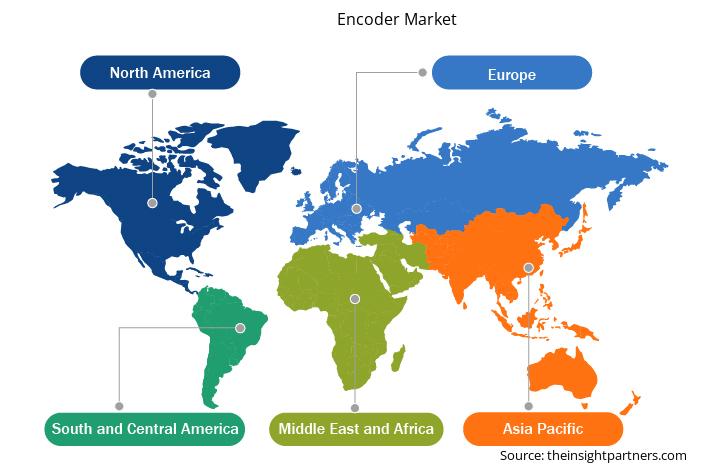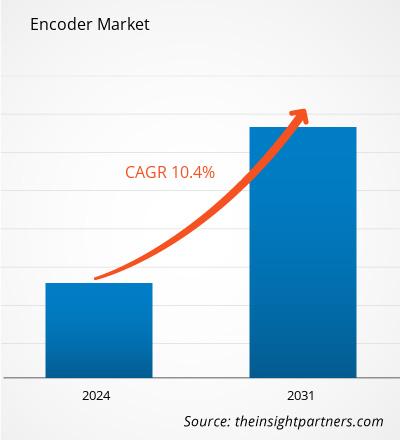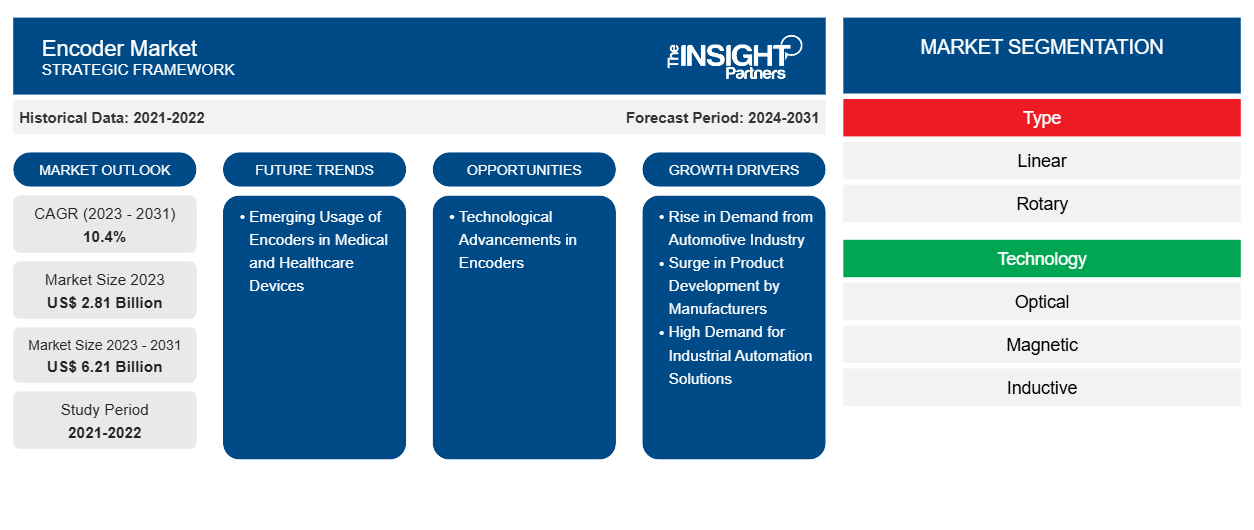Der Markt für Encoder soll von 2,81 Milliarden US-Dollar im Jahr 2023 auf 6,21 Milliarden US-Dollar im Jahr 2031 anwachsen. Der Markt soll zwischen 2023 und 2031 eine durchschnittliche jährliche Wachstumsrate (CAGR) von 10,4 % verzeichnen. Der zunehmende Einsatz von Encodern in medizinischen und Gesundheitsgeräten dürfte in den kommenden Jahren neue Trends auf dem Markt mit sich bringen.
Encoder-Marktanalyse
Die steigende Nachfrage aus der Automobilindustrie, die hohe Nachfrage nach industriellen Automatisierungslösungen bei kleinen, mittleren und großen Unternehmen sowie der Fokus der Hersteller auf die Herstellung neuer Autos sind einige der wichtigen Faktoren, die den Encoder-Markt antreiben . Darüber hinaus erhöhen zunehmende Investitionen in Robotik und industrielle Automatisierungslösungen die weltweite Nachfrage nach Encodern. Darüber hinaus dürften der technologische Fortschritt und die Integration fortschrittlicher Technologien wie die Technologie des industriellen Internets der Dinge (IIoT), Hochgeschwindigkeits-Encoder, HD-Phased-Array-Fotosensoren und ein blauer LED-Chip in Encodern, die die Betriebskosten senken, im Prognosezeitraum Chancen für das Marktwachstum schaffen. Darüber hinaus treiben die steigende Nachfrage nach kundenspezifischen Encodern, der Fokus der Hersteller auf die Entwicklung von Mini-Encodern und eine Steigerung der Forschungs- und Entwicklungsaktivitäten den Encoder-Markt an.
Encoder-Marktübersicht
Ein Encoder ist ein Gerät, das Bewegung in ein elektrisches Signal umwandelt, das von einem Bewegungssteuerungsgerät wie einem Zähler oder einer SPS gelesen werden kann. Er übersetzt Informationen von einem Format oder Code in ein anderes, normalerweise indem er physische Bewegung oder Position in ein digitales Signal umwandelt. Der Encoder sendet ein Rückkopplungssignal aus, mit dem Position, Geschwindigkeit und Richtung berechnet werden können. Dieses Verfahren ist notwendig, um Gleichmäßigkeit, Geschwindigkeit und Komprimierung in einer Vielzahl technischer Anwendungen aufrechtzuerhalten. Encoder spielen eine entscheidende Rolle bei der Übersetzung mechanischer Bewegungen in nutzbare elektrische Daten, die für eine genaue Systemsteuerung und -automatisierung erforderlich sind. Encoder sind wichtige Komponenten moderner Technologie, die Präzision und Kontrolle in einer Vielzahl von Anwendungen gewährleisten, darunter Industriemaschinen und Unterhaltungselektronik. Dieses Maß an Präzision ist für Aufgaben, die eine hohe Genauigkeit erfordern, wie Fließbänder und chirurgische Roboter, unerlässlich. Encoder werden in Unterhaltungselektronikgeräten wie Mäusen und Tastaturen verwendet, um Benutzeraktionen in digitale Signale zu übersetzen, die Computer verarbeiten können, wodurch das Benutzererlebnis und die Benutzereinbindung verbessert werden.
Passen Sie diesen Bericht Ihren Anforderungen an
Sie erhalten kostenlos individuelle Anpassungen an jedem Bericht, einschließlich Teilen dieses Berichts oder einer Analyse auf Länderebene, eines Excel-Datenpakets sowie tolle Angebote und Rabatte für Start-ups und Universitäten.
-
Holen Sie sich die wichtigsten Markttrends aus diesem Bericht.Dieses KOSTENLOSE Beispiel umfasst eine Datenanalyse von Markttrends bis hin zu Schätzungen und Prognosen.
Treiber und Chancen auf dem Encoder-Markt
Steigende Nachfrage aus der Automobilindustrie
Autos werden zunehmend mit einer Reihe fortschrittlicher und digitaler Technologien ausgestattet, um das Fahren für die Benutzer sicherer und komfortabler zu machen. Encoder spielen in der Automobilindustrie eine wichtige Rolle, da sie die Präzision, Leistung und Sicherheit vieler Fahrzeugsysteme verbessern. In modernen und Elektroautos werden Encoder in einer Vielzahl von Anwendungen eingesetzt, darunter unter anderem in elektrischen Servolenkungssystemen (EPS), Motorsteuerungssystemen, Antiblockiersystemen (ABS), Traktionskontrollsystemen, Scheinwerferpositionssteuerung und Batteriesystemen. In EPS-Systemen werden Encoder verwendet, um die Position des Lenkrads zu überwachen, indem sie eine genaue Steuerung und Reaktion gewährleisten. In ABS- und Traktionskontrollsystemen werden Encoder ebenfalls eingesetzt, um ein Durchdrehen der Räder zu erkennen und zu verhindern, was zur Verbesserung der Fahrzeugstabilität beiträgt. Laut dem jährlichen Global Electric Vehicle Outlook 2024 der Internationalen Energieagentur (IEA) wurden beispielsweise im Jahr 2023 weltweit fast 14 Millionen Elektroautos verkauft, das sind 3,5 Millionen mehr als im Jahr 2022, eine Steigerung von 35 % gegenüber dem Vorjahr; damit beträgt die Gesamtzahl der Autos auf den Straßen 40 Millionen. Dieses Wachstum der Anzahl der Autos zeigt, dass der Anteil der Elektroautos am gesamten Automarkt von 14 % im Jahr 2022 auf 18 % im Jahr 2023 gestiegen ist. Die steigenden Verkäufe von Elektroautos weltweit fördern den Einsatz von Encodern bei Automobilherstellern zur Motorsteuerung in Elektro- und Hybridfahrzeugen. Diese Encoder liefern genaue Rückmeldungen zu Motordrehzahl, -position und -richtung und ermöglichen so eine bessere Energieeffizienz und verbesserte Leistung. Die Zuverlässigkeit und Genauigkeit der von Encodern bereitgestellten Rückmeldungen sind für Benutzer und Hersteller von entscheidender Bedeutung, um das Fahrzeughandling zu verbessern, Sicherheitsvorschriften einzuhalten und die autonome Fahrtechnologie zu verbessern. Darüber hinaus steigern der Fortschritt in der Automobilindustrie und die zunehmende Entwicklung in den Bereichen Automatisierung und Elektrifizierung die Nachfrage nach hochpräzisen Encodern. Hochpräzise Encoder werden in autonomen Fahrsystemen wie der adaptiven Geschwindigkeitsregelung eingesetzt, die Raddrehzahl und -position zur Steuerung von Beschleunigung und Bremsen verwendet. Daher treibt die wachsende Nachfrage der Automobilindustrie nach Encoder-ICs den Encodermarkt an.
Technologische Fortschritte bei Encodern
Die steigende Nachfrage nach industrieller Automatisierung, Energieeffizienz und nachhaltigen Lösungen in der Industrie steigert den Bedarf an technologisch fortschrittlichen Encodern weltweit. Die Integration fortschrittlicher Technologien wie des industriellen Internets der Dinge (IIoT) und fortschrittlicher Produkte, darunter Hochgeschwindigkeits-Encoder, HD-Phased-Array-Fotosensoren und ein blauer LED-Chip, mit Encodern kann erweiterte Überwachungs- und Steuerungsfunktionen bieten, die möglicherweise eine Echtzeit-Datenerfassung und -analyse ermöglichen. So hat MELEXIS beispielsweise MLX90382 auf den Markt gebracht, einen Hochgeschwindigkeits-Encoder-IC für industrielle Automatisierung, Robotik und Mobilitätslösungen. MLX90382 ist ein absoluter magnetischer Encoder-IC, der mit einem monolithischen magnetischen Positionssensor integriert ist. Er kombiniert ein Hall-Magnet-Frontend, einen Analog-Digital-Wandler, eine On-Chip-Digitalsignalverarbeitung ohne Latenz und mehrere Ausgangstreiber, wodurch das Gerät für elektromotorbetriebene Anwendungen wie Roboterarme, industrielle Webmaschinen und automatisierte Verpackungsmaschinen geeignet ist. Die Miniaturgröße des MLX90382, die Streufeldimmunität und die Unterstützung von On-Axis- und Off-Axis-Sensoren ermöglichen eine reibungslose Integration in Mikromotoren. Diese Encoder sind darauf ausgelegt, den Bedarf der Industrie an Hochgeschwindigkeits-Feedback zu erfüllen, das für die korrekte Funktion und Sicherheit von Anwendungen mit Elektromotoren unerlässlich ist.
Laut Angaben der Valin Corporation vom Dezember 2022 bietet IIoT Encodern erhebliche Vorteile, indem es die Datenzugänglichkeit, Leistung und Zuverlässigkeit verbessert. IIoT bietet Echtzeitüberwachung und Ferndiagnose, sodass Mitarbeiter den Zustand und die Leistung des Encoders kontinuierlich verfolgen und Ausfallzeiten vermeiden können. Beispielsweise eignet sich der Sendix Industrial Ethernet Encoder von Kubler mit integrierter OPC UA-Schnittstelle hervorragend für IIoT-Anwendungen. Er ist in der Lage, die steuerungsunabhängige Kommunikation mit einer Cloud-Lösung oder einem anderen übergeordneten System zu automatisieren. Die Konfiguration des Encoders über das Internet ermöglicht eine systemübergreifende Kommunikation und behebt im Falle eines Ausfalls schnell und effizient Fehler. So unterstützen beispielsweise die mit den Schnittstellen Profinet, EtherCAT oder EtherNet/IP integrierten Industrial Ethernet Encoder von Kubler die OPC UA-Schnittstelle, wodurch die Vielseitigkeit erhöht wird und die gleichzeitige Übertragung von Daten an die Steuerung, den Webserver oder die Cloud ermöglicht wird. Durch die Integration von Encodern in IIoT-fähige Systeme können Daten von diesen Geräten gesammelt, verarbeitet und auf Cloud-basierten Plattformen gespeichert werden, was wichtige Einblicke in Gerätemuster und Betriebseffizienz bietet.
Daher ist zu erwarten, dass der technologische Fortschritt bei Encodern im Prognosezeitraum Chancen für das Wachstum des Encodermarktes schaffen wird.
Segmentierungsanalyse des Encoder-Marktberichts
Schlüsselsegmente, die zur Ableitung der Encoder-Marktanalyse beigetragen haben, sind Typ und Technologie.
- Basierend auf dem Typ ist der Encodermarkt in lineare und rotierende Encoder unterteilt. Das rotierende Segment hatte im Jahr 2023 einen größeren Marktanteil.
- Basierend auf der Technologie ist der Encodermarkt in optische, magnetische, induktive und andere Segmente unterteilt. Das optische Segment hatte im Jahr 2023 den größten Marktanteil.
Encoder-Marktanteilsanalyse nach Geografie
Der geografische Umfang des Encoder-Marktberichts ist hauptsächlich in fünf Regionen unterteilt: Nordamerika, Asien-Pazifik, Europa, Naher Osten und Afrika sowie Süd- und Mittelamerika.
Nordamerika hatte im Jahr 2023 einen bedeutenden Marktanteil. Die USA, Kanada und Mexiko gehören zu den größten Volkswirtschaften Nordamerikas. Die Region trägt aufgrund der wachsenden Investitionen der Industrie in die Einführung von Robotern einen bemerkenswerten Anteil zum globalen Encoder-Markt bei. Laut den im April 2024 veröffentlichten Daten der International Federation of Robotics (IFR) investieren Industrien in den USA, Kanada und Mexiko beispielsweise stark in die Einführung und Installation von Robotern zur Automatisierung industrieller Prozesse. Die wichtigsten Branchen, die stark in Robotertechnologien investieren, sind die Automobil-, Elektro-, Elektronik- und Fertigungsindustrie, was die Nachfrage nach Encodern zur Steuerung der Position, Geschwindigkeit und Bewegung von Roboterteilen erhöht.IFR) data published in April 2024, industries in the US, Canada, and Mexico are investing heavily in adopting and installing robots for automating industrial processes. Automotive, electrical, electronics, and manufacturing are the major industries investing significantly in robotics technologies, increasing the demand for encoders to navigate the position, speed, and motion of robotic parts.
Die USA sind nach China der weltweit zweitgrößte Produzent von Autos und leichten Fahrzeugen. Die Verkäufe auf dem Automobilmarkt in den USA stiegen um 1 %, wobei 2023 ein Rekord von 14.678 installierten Robotern verzeichnet wurde, was einem Anstieg von 47 % entspricht, wobei 2022 14.472 Einheiten installiert wurden. 2023 entfallen 33 % aller Industrierobotereinsätze im Land auf Automobil- und Komponentenhersteller. Ebenso stiegen 2023 die Roboterinstallationen in Kanada um 43 % auf 4.616 Einheiten. 55 % der Roboterinstallationen des Landes entfielen auf die Automobilindustrie, und die Verkäufe im Automobilsektor stiegen um 99 %, wobei im Jahr 2023 2.549 Einheiten installiert wurden. Darüber hinaus erreichte die Zahl der in der mexikanischen Fertigungsindustrie installierten Roboter im Jahr 2023 5.868 Einheiten in der Automobilindustrie. Die Automobilindustrie ist der größte Roboteranwender des Landes und macht 69 % der Gesamtinstallationen aus, wobei die Verkäufe im Jahr 2023 insgesamt 4.068 Einheiten betrugen. Die wachsende Expansion der Automobilindustrie und die zunehmende Installation von Robotern führten zu einem Anstieg des Einsatzes von Encodern in den Automobilproduktionslinien. Encoder werden in Automobilproduktionslinien verwendet, um eine gleichbleibende Präzision aufrechtzuerhalten, Fehler zu reduzieren und sich wiederholende Aktionen für Roboter sicherzustellen. Roboter in der Automobilindustrie sind für Aufgaben wie Teileinstallation, Beschichtungsauftrag und komplizierte Schweißvorgänge verantwortlich. Encoder ermöglichen es Robotern, in Echtzeit auf Positionsunterschiede zu reagieren, indem sie die Effizienz und Qualität der Prozesse optimieren.
Regionale Einblicke in den Encoder-Markt
Die regionalen Trends und Faktoren, die den Encoder-Markt im Prognosezeitraum beeinflussen, wurden von den Analysten von Insight Partners ausführlich erläutert. In diesem Abschnitt werden auch die Marktsegmente und die Geografie des Encoder-Marktes in Nordamerika, Europa, im asiatisch-pazifischen Raum, im Nahen Osten und Afrika sowie in Süd- und Mittelamerika erörtert.

- Holen Sie sich die regionalspezifischen Daten für den Encoder-Markt
Umfang des Encoder-Marktberichts
| Berichtsattribut | Details |
|---|---|
| Marktgröße im Jahr 2023 | 2,81 Milliarden US-Dollar |
| Marktgröße bis 2031 | 6,21 Milliarden US-Dollar |
| Globale CAGR (2023 - 2031) | 10,4 % |
| Historische Daten | 2021-2022 |
| Prognosezeitraum | 2024–2031 |
| Abgedeckte Segmente |
Nach Typ
|
| Abgedeckte Regionen und Länder |
Nordamerika
|
| Marktführer und wichtige Unternehmensprofile |
|
Dichte der Marktteilnehmer für Encoder: Auswirkungen auf die Geschäftsdynamik verstehen
Der Encoder-Markt wächst rasant, angetrieben durch die steigende Nachfrage der Endnutzer aufgrund von Faktoren wie sich entwickelnden Verbraucherpräferenzen, technologischen Fortschritten und einem größeren Bewusstsein für die Vorteile des Produkts. Mit steigender Nachfrage erweitern Unternehmen ihr Angebot, entwickeln Innovationen, um die Bedürfnisse der Verbraucher zu erfüllen, und nutzen neue Trends, was das Marktwachstum weiter ankurbelt.
Die Marktteilnehmerdichte bezieht sich auf die Verteilung der Firmen oder Unternehmen, die in einem bestimmten Markt oder einer bestimmten Branche tätig sind. Sie gibt an, wie viele Wettbewerber (Marktteilnehmer) in einem bestimmten Marktraum im Verhältnis zu seiner Größe oder seinem gesamten Marktwert präsent sind.
Die wichtigsten auf dem Encoder-Markt tätigen Unternehmen sind:
- Asahi Kasei Microdevices Corp
- Vishay Intertechnology Inc
- Sick AG
- Honeywell International Inc
- ROHM Co Ltd
- Allegro MicroSystems Inc
Haftungsausschluss : Die oben aufgeführten Unternehmen sind nicht in einer bestimmten Reihenfolge aufgeführt.

- Überblick über die wichtigsten Akteure auf dem Encoder-Markt
Neuigkeiten und aktuelle Entwicklungen zum Encoder-Markt
Der Encoder-Markt wird durch die Erhebung qualitativer und quantitativer Daten nach Primär- und Sekundärforschung bewertet, die wichtige Unternehmensveröffentlichungen, Verbandsdaten und Datenbanken umfasst. Nachfolgend sind einige der Entwicklungen auf dem Encoder-Markt aufgeführt:
- OMRON Automation, ein führender Anbieter fortschrittlicher industrieller Automatisierungslösungen in Indien, will seine Geschäftsstrategie rund um i-Belt, den datengesteuerten Co-Creation-Lösungsservice des Unternehmens, verstärken. OMRON ist für sein umfangreiches Portfolio bekannt, das intelligente Sensoren, Roboter, Bildverarbeitung, Maschinensicherheit, SPS, Servos und Antriebe umfasst. Durch die Integration mit dem datenbasierten Service i-Belt will das Unternehmen sein Angebot an End-to-End-Lösungen weiter erweitern. (Quelle: OMRON, Pressemitteilung, August 2023)
- Microchip Technology Inc. kündigte eine mehrjährige Initiative im Wert von über 300 Millionen US-Dollar an, um seine Präsenz in Indien auszubauen. Mit dieser Investition will das Unternehmen im Land Zentren für Halbleiterforschung, Chipdesign und Gerätetechnik aufbauen. Im selben Monat eröffnete Microchip Technology Inc. ein Forschungs- und Entwicklungszentrum in Hyderabad. Nach Angaben des Unternehmens dürfte der Halbleitermarkt in Indien von 22,7 Milliarden US-Dollar im Jahr 2019 bis 2026 auf 64 Milliarden US-Dollar anwachsen. (Quelle: Microchip Technology Inc., Pressemitteilung, Juli 2024)
Encoder-Marktbericht – Umfang und Ergebnisse
Der Bericht „Encoder-Marktgröße und -prognose (2021–2031)“ bietet eine detaillierte Analyse des Marktes, die die folgenden Bereiche abdeckt:
- Encoder-Marktgröße und -prognose auf globaler, regionaler und Länderebene für alle wichtigen Marktsegmente, die im Rahmen des Berichts abgedeckt sind
- Encoder-Markttrends sowie Marktdynamik wie Treiber, Einschränkungen und wichtige Chancen
- Detaillierte PEST- und SWOT-Analyse
- Encoder-Marktanalyse mit wichtigen Markttrends, globalen und regionalen Rahmenbedingungen, wichtigen Akteuren, Vorschriften und aktuellen Marktentwicklungen
- Branchenlandschaft und Wettbewerbsanalyse, einschließlich Marktkonzentration, Heatmap-Analyse, prominenten Akteuren und aktuellen Entwicklungen für den Encoder-Markt
- Detaillierte Firmenprofile
- Historische Analyse (2 Jahre), Basisjahr, Prognose (7 Jahre) mit CAGR
- PEST- und SWOT-Analyse
- Marktgröße Wert/Volumen – Global, Regional, Land
- Branchen- und Wettbewerbslandschaft
- Excel-Datensatz
Aktuelle Berichte
Erfahrungsberichte
Grund zum Kauf
- Fundierte Entscheidungsfindung
- Marktdynamik verstehen
- Wettbewerbsanalyse
- Kundeneinblicke
- Marktprognosen
- Risikominimierung
- Strategische Planung
- Investitionsbegründung
- Identifizierung neuer Märkte
- Verbesserung von Marketingstrategien
- Steigerung der Betriebseffizienz
- Anpassung an regulatorische Trends























 Kostenlose Probe anfordern für - Encoder-Markt
Kostenlose Probe anfordern für - Encoder-Markt